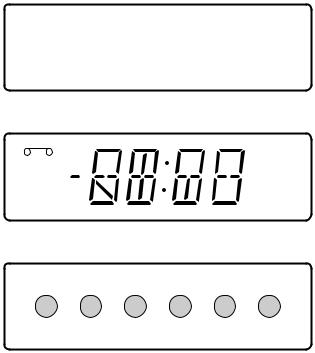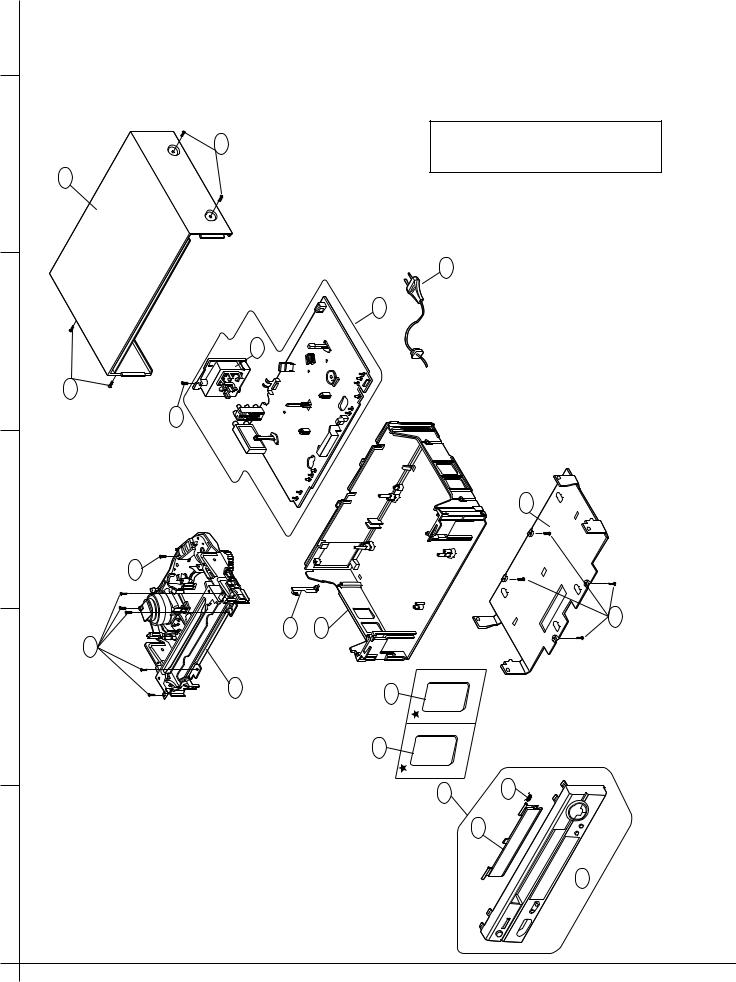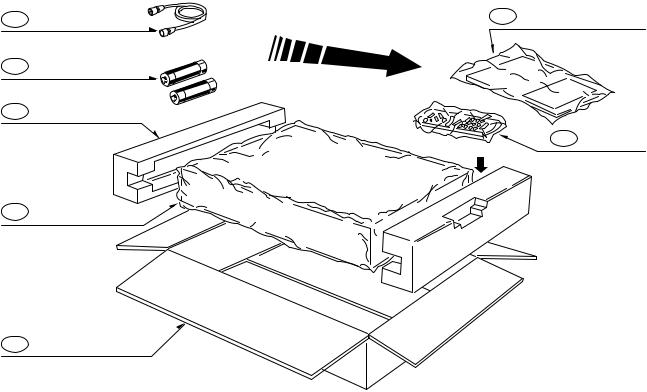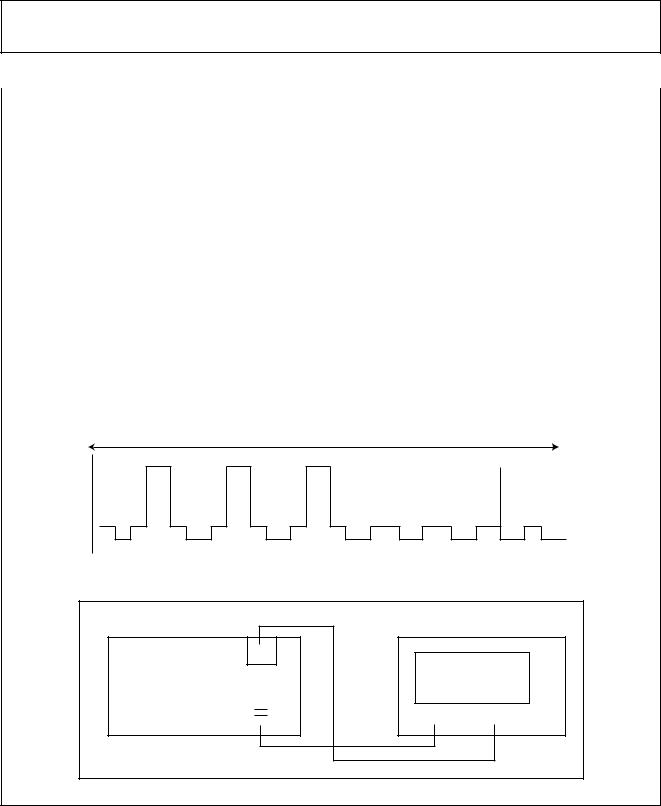LG L316 Service manual
LG L316
SECTION1 SUMMARY
KEY TO ABBREVIATIONS
A |
AC |
:Alternating Current |
|
ACC |
:Automatic Color Control |
|
ACSS |
:Automatic Channel Setting System |
|
ADJ |
:Adjust |
|
A/E |
:Audio Erase |
|
AFC |
:Automatic Frequency Control |
|
AFT |
:Automatic Fine Tuning |
|
AGC |
:Automatic Gain Control |
|
A.H.SW |
:Audio Head Switch |
|
ALC |
:Automatic Level Control |
|
AM |
:Amplitude Modulation |
|
AMP |
:Amplifier |
|
ANT |
:Antenna |
|
APC |
:Automatic Phase Control |
|
ASS’Y |
:Assembly |
|
AUX |
:Auxiliary |
B |
B |
:Base |
|
BGP |
:Burst Gate Pulse |
|
BPF |
:Bandpass Filter |
|
BS |
:Brodcasting Satellite |
|
BW or B/W |
:Black and White |
C |
C |
:Capacitor, Chroma, Collector |
|
CAN |
:Cancel |
|
CAP |
:Capstan |
|
CAP.BRK |
:Capstan Brake |
|
CAP.RVS |
:Capstan Reverse |
|
CATV |
:Cable Television |
|
CBA |
:Circuit Board Assembly |
|
CCD |
:Charge Coupled Device |
|
C.CTL |
:Chro Control, Capstan Control |
|
CFG |
:Capstan Frequency Generator |
|
CHROMA |
:Chrominance |
|
CNR |
:Chroma Noise Redution |
|
COMB |
:Combination |
|
|
Comb Filter |
|
COMP |
:Comparator |
|
|
Composite |
|
|
Compensation |
|
CONV |
:Converter |
|
C.ROT SW |
:Color Rotary Switch |
|
CS |
:Chip Selcet |
|
C.SYNC |
:Composite Synchronization |
|
CTL DIV |
:Control Divide |
|
CUR |
:Current |
|
CYL |
:Cylinder |
D |
D |
:Drum, Digital, Diode, Drain |
|
D.ADJ |
:Drum Adjust |
|
DC |
:Direct Current |
|
D.CTL |
:Drum Control |
|
DEMOD |
:Demodulator |
|
DET |
:Detector |
|
DEV |
:Deviation |
|
DHP |
:Double High Pass |
|
DIGITRON |
:Digital Display Tube |
|
DL |
:Delay line |
|
DOC |
:Drop Out Compensator |
|
DUB |
:Dubbing |
|
D.V SYNC |
:Dummy Vertical Synchronization |
E |
E |
:Emitter |
|
EE |
:Electric to Eletric |
|
EMPH |
:Emphasis |
|
ENA |
:Enable |
|
ENV |
:Envelope |
|
EP |
:Extended Play |
|
EQ |
:Equalizer |
|
EXP |
:Expander |
F |
F |
:Fuse |
|
FB |
:Feed Back |
|
FBC |
:Feed Back Clamp |
|
FE |
:Full Erase |
|
FG |
:Frequency Generator |
|
FL |
:Filter |
|
FM |
:Frequency Modulation |
|
F/R |
:Front/Rear |
|
FS |
:Frequency Synthesizer |
|
FSC |
:Subcarrier Frequency |
|
F/V |
:Frequency Voltage |
G |
GEN |
:Generator |
H |
H |
:High, Horizontal |
I |
IC |
:Integrated Circuit |
|
IF |
:Intermediate Frequency |
|
INS |
:Insert |
L |
L |
:Low, Left, Coil |
|
LD |
:LED |
|
LD VTG CTL |
:Loading Voltage Control |
|
LECHA |
:Letter Character |
|
L.M |
:Level Meter |
|
LP |
:Long Play |
|
LPF |
:Low Pass Filter |
M |
MAX |
:Maximum |
|
MD |
:Modulator |
|
MECHA.CTL |
:Mechanism Control |
|
MIC |
:Microphone |
|
MIN |
:Minimum |
|
MIX |
:Mixer, Mixing |
|
M.M. |
:Monostable, Multivibrator |
|
MMV |
:Mono Multi Vibrator |
|
MOD |
:Modulation, Modulator |
|
MODEM |
:Modulator-Demodulator |
|
MPX |
:Multiplex |
N |
NR |
:Noise Reduction |
|
|
|
O |
OSC |
:Oscillator |
|
OSD |
:On Screen Display |
P |
PB |
:Playback |
|
PCB |
:Printed Circuit Board |
|
P.CTL |
:Power Control |
|
PRE-AMP |
:Preamplifier |
|
P.F |
:Power Failure |
|
PG |
:Pulse Generator |
|
PLL |
:Phase Locked Loop |
|
PREM.DET |
:Premire Detect |
|
P.P |
:Peak-to-Peak |
|
PS |
:Phase Shift |
|
PWM |
:Pulse Width Modulation |
|
PWR CTL |
:Power Control |
Q |
Q |
:Transistor |
|
QH |
:Quasi Horizontal |
|
QSR |
:Quick Setting Record |
|
QTR |
:Quick Timer Record |
|
QV |
:Quasi Vertical |
R |
R |
:Resistor, Right |
|
RE(or RC) |
:Remocon, Receiver |
|
REC |
:Recording |
|
REC S ‘H’ |
:Record Start ‘Hight’ |
|
REF |
:Reference |
|
REG |
:Regulated, Regulator |
|
REMOCON |
:Remote Control(unit) |
|
RF |
:Radio Frequency |
|
R/P |
:Record/Playback |
|
RTC |
:Reel Time Counter |
S |
S |
:Serial |
|
S.ACCEL |
:Slow Accel |
|
SAOP |
:Second Audio Program |
|
SC |
:Scart, Simulcast |
|
S.DET |
:Secam Detect |
|
SH |
:Shift |
|
SHARP |
:Sharpness |
|
SIF |
:Sound Intermediate Frequency |
|
SLD |
:Side Locking |
|
S/N |
:Signal to Noise Ratio |
|
SP |
:Standard Play |
|
ST |
:Stereo |
|
SUB |
:Subtract, Subcarrier |
|
SW or S/W |
:Switch |
|
SYNC |
:Synchronization |
|
SYSCON |
:System Control |
T |
T |
:Coil |
|
TP |
:Test Point |
|
TR |
:Transistor |
|
TRK |
:Tracking |
|
TRANS |
:Transformer |
|
TU |
:Tuner, Take-up |
U |
UHF |
:Ultra High Frequency |
|
UNREG |
:Unregulated |
V |
V |
:Volt, Vertical |
|
VA |
:Always Voltage |
|
VCO |
:Voltage Controlled Oscillator |
|
VGC |
:Voltage Gain Control |
|
VHF |
:Very High Frequency |
|
V.H.SW |
:Video Head Switch |
|
VISS |
:VHS Index Search |
|
VPS |
:Video Program System |
|
VR |
:Variable Resistor or Volume |
|
V-SYNC |
:Vertical Synchronization |
|
VTG |
:Voltage |
|
VV |
:Voltage to Voltage |
|
VXO |
:Voltage X-tal Oscillator |
W |
W |
:Watt |
|
WHT |
:White |
|
W/O |
:With out |
X |
X-TAL |
:Crystal |
Y |
Y/C |
:Luminance/Chrominance |
|
YNR |
:Luminance Noise Reduction |
Z |
ZD |
:Zener Diode |
1-2

IMPORTANT SAFETY PRECAUTIONS
Prior to shipment from the factory, the products are strictly inspected to confrom with the recognized product safety and electrical codes of the countries in which they are to be sold. However, in order to maintain such compliance, it is equally important to implement the following precautions when a set is being serviced.
• Precautions during Servicing
1.Locations requiring special caution are denoted by labels and inscriptions on the cabinet, chassis and certain parts of the product. When performing service, be sure to read and comply with these and other cautionary notices appearing in the operation and service manuals.
2.Parts identified by the  symbol and shaded ( Y ) parts are critical for safety. Replace only with specified part numbers.
symbol and shaded ( Y ) parts are critical for safety. Replace only with specified part numbers.
Note : Parts in this category also include those specified to comply with X-ray emission standards for products using cathode ray tubes and those specified for compliance with various regulations regarding spurious radiation emission.
3.Use Specified internal wiring. Note especially:
1)Double insulated wires
2)High voltage leads
4.Use specified insulating materials for hazardous live parts. Note especially:
1)Insulation Tape
2)PVC tubing
3)Spacers
4)Insulation sheets for transistor
5.Observe that wires do not contact heat producing parts (heatsinks, oxide metal film resistors, fusible resistors, etc.)
6.Check that replaced wires do not contact sharp edged or pointed parts.
7. |
1) |
When a power cord has been replaced, check |
|
|
|
that A mark is made on the cord, under strain, |
|
|
|
near the aperture, and the flexible cord is |
|
|
|
subjected 100 times to a pull of 40N for a duration |
Power code |
|
|
of 1 second each. |
|
|
2) |
During the test, the cord shall not be displaced by |
|
|
|
more than 2mm |
|
8. |
Also check areas surrounding repaired locations. |
Fig. 1 |
|
9.The internal wiring is secured so as not to approach the heating parts and high voltage parts by its shape. So, these wires must be restored to its former state.
1-3

SAFETY CHECK AFTER SERVICING
Examine the area surrounding the repaired location for damage or deterioration. Observe that screws, parts and wires have been returned to original positions. Afterwards, perform the following tests and confirm the specified values in order to verify compliance with safety standards.
• Insulation resistance test
confirm the specified insulation resistance or greater between power cord plug prongs and externally exposed parts of the set (RF terminals, antenna terminals, video and audio input and output terminals, incrophone jacks, earphone jacks, etc.) See table below.
• Dielectric strength test
Confirm specified dielectric strength or greater between power cord prongs and exposed accessible parts of the set (RF terminals, antenna terminals, video and
audio input and output terminals, incrophone jacks,
earphone jacks, etc.) See table below.
d
• Clearance distance |
|
|
|
|
|
|
|
|
|
|
Primary |
circuit terminals |
||
When replacing primary circuit components, confirm |
Chassis |
|
|
|
|
|
|
|
|
|
||||
|
|
|
|
|
|
|
|
|
||||||
|
|
|
|
|
|
|
|
|
||||||
specified clearance distance (d), (d') between sol- |
|
|
|
|
|
|
|
|
a |
|
||||
|
|
|
|
|
|
|
|
|||||||
dered terminals, and between terminals and sur- |
|
|
|
|
|
|
|
|
|
|
||||
|
|
|
|
|
|
|
|
|
|
|||||
rounding metallic parts. See table below. |
|
|
|
|
|
|
|
|
|
|
|
|
||
|
|
|
|
|
|
|
|
|
|
|
|
|
||
Table 1 : Ratings for selected areas |
|
|
|
|
|
|
|
Fig. 2 |
|
|||||
|
|
|
|
|
|
|
|
|
|
|
|
|||
|
|
|
|
|
|
|
|
|
|
|
||||
|
AC Line Voltage |
Region |
|
Insulation |
|
|
|
Dielectric |
|
Clearance |
||||
|
|
Resistance |
|
|
|
|
Strength |
|
Distance(d),(d) |
|||||
|
|
|
|
|
|
|
|
|
||||||
|
|
|
|
|
|
|
|
|
|
|
|
|
|
|
|
*100 to 130 V |
Europe |
F |
10 MΩ/500 V DC |
|
|
4kV 1 minute |
|
F 6mm(d) |
|||||
|
*200 to 240 V |
Australia |
|
|
|
F 8mm(d) |
||||||||
|
|
|
|
|
|
|
|
|
|
|
|
(a Power cord) |
||
*Class II model only.
Note. This table is unofficial and for reference only. Be sure to confirm the precise values for your particular country and locality.
•Leakage Current test
Confirm specified or lower leakage current between B(earth ground, power cord plug prongs) and externally exposed accessible parts (RF terminals, antenna terminals, video and audio input and output terminals, microphone jacks, earphone jacks, etc.)
|
|
|
|
Exposed |
|
|
|
|
|
|
|
|
|
|
|
|
|
|
|
|
|
|
|
|
|
|
|
|
|
|
|
|
|
|
|
|
|
||
Measuring Method: (Power ON) |
|
|
accessible |
|
|
|
|
|
|
|
|
|
|
|
|||||
|
|
part |
|
|
|
|
Z |
|
|
|
|
|
|
AC Voltmeter |
|||||
Insert load Z between B(earth ground, power cord |
|
|
|
|
|
|
|
|
|
|
|||||||||
|
Load |
|
|
|
|
|
|
|
|
||||||||||
plug prongs) and exposed accessible parts. Use an |
|
|
|
|
|
|
|
|
Earth |
Ground, |
|||||||||
AC voltmeter to measure across both terminals of |
|
|
|
|
|
|
|
|
|||||||||||
|
|
|
|
|
|
|
|
Power cord plug prongs |
|||||||||||
|
|
|
|
|
|
||||||||||||||
load Z. See figure and following table. |
|
|
|
|
|
|
|
B |
|
|
|
|
|||||||
|
|
|
|
|
|
|
|
|
|
|
|
|
|
|
|
|
|||
Table 2:Leakage current ratings for selected areas. |
|
|
|
|
|
|
|
|
Fig. 3 |
|
|
|
|
||||||
|
|
|
|
|
|
|
|
|
|
|
|
|
|
|
|
|
|
|
|
AC Line Voltage |
Region |
Load Z |
|
Leakage Current(i) |
|
Earth Ground |
|||||||||||||
|
|
(B) to : |
|||||||||||||||||
|
|
|
|
|
|
|
|
|
|
|
|
|
|
|
|
|
|
|
|
100 to 130 V |
Europe |
|
|
|
i E 0.7m A peak |
|
|
|
Antenna earth |
||||||||||
2kΩ |
|
i E 2m A DC |
|
|
|
terminals |
|||||||||||||
|
|
|
|
|
|
||||||||||||||
200 to 240 V |
Australia |
|
|
|
i E 0.7m A peak |
|
|
|
Other terminals |
||||||||||
50k |
|
i E 2m A DC |
|
|
|
||||||||||||||
|
|
|
Ω |
|
|
|
|
|
|
|
|
|
|
|
|
|
|
|
|
Note. This table is for IEC member only. Be sure to confirm the precise values for your particular country and Note. locality.
1-4

SERVICE NOTICE ON REPLACING EEPROM
In case that defective EEPROM of PAL models is replaced, to operate these sets from the initial state MP KEY must be repaired as well before delivering to the customer.
If MP KEY isn’t repaired the setting of RF OUT channel or LANGUAGE might be different from that for custormer’s country.
•MP KEY : In case of PAL VCR if holding the REC button on the front panel and the CLEAR button on the remote control handset for 5 ~ 7 seconds with power being switch all and no tapes,
OK is displayed at FLD for FLD models and LED becomes on for LED CLOCK models. This is the state that initializing EEPROM is finished.
(In case of PAL VCP if holding the REC button on the front panel and the MENU button on the remote control handset for 5 ~ 7 seconds with power being off and no tapes, All the LED DOTs become on. This is the state that initializing EEPROM is finished.)
•MP KEY's function : MP KEY sets EEPROM's data up to the initial state.
OK
•FLD MODEL:
MP KEY “OK”
|
|
TIMER |
• LED CLOCK MODEL: |
||
REC |
|
||||
|
|
|
|
||
|
|
|
|
|
MP KEY Switch all on a Light |
VCR |
|
|
AM |
|
|
|
|
|
|
||
• LED DOT MODEL:
MP KEY Switch all on a Light
1-5

PREDICTED ERRORS OF MODULATOR & HOW TO COPE WITH THEM
CONTENT
Handle RF OUT CH by each region
For G : 30 ~ 40 ch For I : 30 ~ 40 ch 30 ~ 40 ch
For G/K : 30 ~ 40 ch (G-initial for Australia) 30 ~ 40 ch (K-initial for CIS)
30 ~ 40 ch (G-initial for Southeast asia)
PREDICTED ERRORS
1.In RF Inteference, it is impossible to control from the outside.
2.After forwarding models with G/K system for G/K, it is difficult to change system.
HOW TO HANDLE
1.To subdivide CH according to model and region.
2.To adjust CH or System after open the top case.
1-6

|
SPECIFICATIONS |
|
|
General |
|
Power .................................... |
AC110~240V, 50/60Hz |
Power consumption .............. |
Approx. 10 Watts |
Dimensions (W x H x D) ....... |
360 x 94 x 230 mm |
Weight ................................... |
Approx. 3.0 Kg. |
Operating temperature.......... |
5 ~ 35°C |
Operating humidity................ |
Less than 80% |
Video |
|
Television system.................. |
CCIR standard (625 lines, 50 fields), PAL/SECAM colour signal |
Recording format .................. |
PAL/MESECAM/NTSC3.58/NTSC4.43 |
RF OUT................................. |
PAL/SECAM(G or K) |
Input level.............................. |
1.0Vp-p, 75 Ohm, unbalanced |
Output level .......................... |
1.0Vp-p, 75 Ohm, unbalanced |
RF modulator ........................ |
UHF channels 32~40 (adjustable) |
Audio |
|
Input level.............................. |
-6 dBm, more than 47 kOhms |
Output level........................... |
-6 dBm, less than 1.5 kOhms |
Audio track ........................... |
Mono track |
Audio frequency response .... |
100 Hz ~ 10kHz(-6/+3 dBm) |
• Design and specifications are subject to change without notice.
1-8

SECTION2 CABINET & MAIN FRAME
SERVICE METHOD
(1) Disassembly Flow
Top Case
Bottom Cover
Front Panel
Housing & Deck
Assembly
Main C.B.A
LED C.B.A
(2) Re-assembly Flow for service like Fig. 2-1
LED C.B.A
Main C.B.A
Housing & Deck
Assembly
(3)To check and replace Electrical parts
1Disassemble the unit according to No.1) Disassembly Flow.
2Re-assemble the unit according to No.2) Re-assembly Flow.
3Place the unit like Fig. 2-1
4Check and replace Electrical parts.
NOTE :
1Insert Video Cassette Tape inversely like Fig. 2-1 to check and replace defective parts.
2In disassembling and reassembling, be careful not to damaged CST switch.
(Positioned Upside Down) |
C.B.A Princioal |
Housing y Mecanismo |
Cassette Tape |
(Upside Down) |
Fig.2-1 |
2-1 |

5
4
3
2
1
EXPLODED VIEWS
1. Cabinet and Main Frame Section
462
250
A46
320
462 457
NOTE) Refer to “SECTION 5 REPLACEMENT PARTS LIST” in order to look for the part number of each part.
_ OPTIONAL PARTS
300
|
|
330 |
464 |
|
|
261 |
260 |
452 |
457 |
|
|
A00 |
|
A49 |
|
|
A42 |
A43 |
284 |
283
 280
280
A |
B |
C |
D |
2-2

2. Packing Accessory Section
810 CABLE SET ASS'Y |
801 INSTRUCTION ASS'Y |
808 BATTERY
(Optional Parts)
803 PACKING ASS'Y
900 REMOCON
804 SHEET CUSHION
802BOX CARTON
•Packing Accessory Section Part List
2-4

SECTION 3 ELECTRICAL
ELECTRICAL ADJUSTMENT POINTS ARRANGEMENT
:Measurement point
:Adjustment point
|
|
A/V JACK |
M |
|
|
|
O |
SMPS |
AVCP |
|
D |
|
Hi-Fi |
U |
|
|
DECK CNT. |
L |
|
|
|
||
|
|
|
A |
S |
A/V |
MODULATOR |
T |
O |
|||
M |
|
|
R |
|
|
|
|
P |
|
|
|
S |
SYSTEM |
|
|
|
|
|
|
|
|
U-COM |
|
|
DISP |
|
|
KEY |
|
KEY |
|
BOARD(L) |
|
BOARD(R) |
|
3-1

ELECTRICAL ADJUSTMENT PROCEDURES
1.Servo Adjustment
1)PG Adjustment
• Test Equipment
a) OSCILLOSCOPE
b) PAL TEST TAPE (VHS SP)
• Adjustment And Specification
MODE |
MEASUREMENT POINT |
ADJUSTMENT POINT |
SPECIFICATION |
|
|
|
|
|
|
SP TAPE PLAY |
V.Out Jack |
AUTO |
PAL PG : 416 ± 32usec |
|
H/SW(W373, W374) |
NTSC : 412 ± 32usec |
|||
|
|
|||
|
|
|
|
•Adjustment Procedure and Caution a) Insert the PAL SP Test Tape and play.
Note - Adjust the distance of X, pressing SET REC KEY and “OK” on RCU simultaneously. (3SEC HOLD). In ININTIAL MODE, LED of POWER/CST IN/LP/EP/STANDBY is on .(TRK PRESET MODE)
b) In TRK PRESET MODE,Pressing SET REC KEY and “OK” on RCU same, and then PG is adjusted automatically. (LED of PLAY/REC is off.)
c) Connect the CH1 of the oscilloscope to the H/SW(W373, W374) and CH2 to the Video Out for the VCR. d) Trigger the mixed Video Signal of CH2 to the CH1 H/SW(W373, W374), and then check the distance (time difference), which is from the selected A(B) Head point of the H/SW(W373, W374) signal to the
starting point of the vertical synchronized signal, to 416 µsec ± 32 µsec.
•WAVEFORM
t=416 sec ± 32 sec
• CONNECTION
VIDEO |
|
OUT |
|
W373/W374 |
CH-1 CH-2 |
Fig. 3-2
3-2
